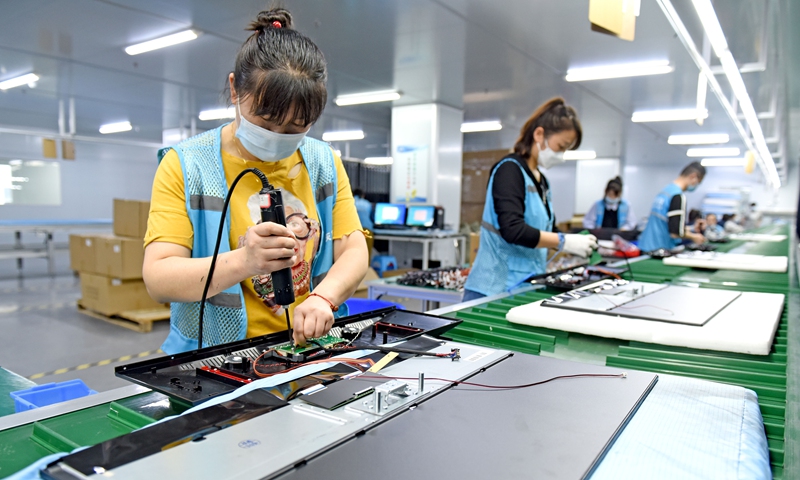
Workers manufacture display panels on an assembly line in Huainan High-Tech Industrial Development Zone in East China's Anhui Province, on April 24, 2022. Photo: VCG
China's factory activity expanded at a slower pace in June, a private survey showed on Monday, indicating that the world's second-largest economy maintained a continuous recovery while still facing downward pressure.
Despite some problems including unstable geopolitical situation, relatively weak demand and poor market expectations, China remains the main driver of the economic growth of Asia and the world, and its GDP growth rate in the first half of this year is expected to reach 5.5 percent, experts noted.
China's private Caixin Manufacturing Purchasing Managers' Index (PMI) reached 50.5 in June, a small decline of 0.4 percentage points from May, with the reading remaining in the expansionary territory for a second consecutive month.
The survey showed that the expansion of both manufacturing output and new orders softened in June. Due to lower-than-expected sales growth, enterprises maintained a cautious approach to employment, which fell for the fourth month in a row.
Caixin chief economist Wang Zhe said on Monday that China's economic recovery is not solid, and prominent issues including the lack of internal growth drivers, weak demand and poor market expectations still exist.
"Data showed that companies are cautious about the future market outlook, and consumers have poor expectations for the future, mainly due to the external environment including the continuous interest rate hikes in Europe and the US and the tension between China and the US," Tian Yun, an independent macro analyst, told the Global Times on Monday.
The country released its June official manufacturing PMI on Friday, which stood at 49, up 0.2 percentage points compared with May. The index, however, recorded a contraction in June for the third consecutive month.
As China faces some challenges from a drop in demand for its exports due to a worldwide economic slump, some Western media outlets alleged that China's recent economic slowdown will lag the recovery of the rest of Asia this year.
China will "barely reach" its GDP growth target of about 5 percent, which is "quite low" compared to Southeast Asia, according to a report by the VOA, citing Alicia Garcia Herrero, chief economist for Asia Pacific at Natixis, a French investment bank.
In response, Tian said that from domestic demand or foreign trade, China's economy continues to perform well among Asian countries. For instance, South Korea, as an export-oriented Asian country, reported in May an export decrease for the eighth consecutive month, and Vietnam saw a 12.3 percent drop year-on-year in exports during the first five months.
"Both export-oriented countries did not outperform China in exports," Tian said.
The Asia-Pacific will remain a dynamic region in 2023 despite global banks' monetary tightening and lackluster market demand, and the region's dynamism is driven primarily by China's recovery, the IMF said in May.
And, China will contribute 34.9 percent of global economic growth, and a 1 percentage point increase in GDP growth in China leads to a 0.3 percentage point increase in growth in other Asian economies, according to the fund.
"The country's GDP growth rate in the second quarter is expected to be higher than [that of] the first quarter, which will stand at 6.5 percent, and that of the first half of this year will reach 5.5 percent. China will continue to be a major driver of the economic recovery of Asia and the world," Tian noted.
China has rolled out a range of measures over the recent months to shore up the economy. The country has released new policies to boost consumption in new-energy vehicles and household consumption. The central bank in June also cut several key policy rates, the first such move in 10 months.
Tian said that the government's economic policies this year focus more on the consumption, instead of the government spending or the real state.
Tian noted that there is still more room for the government to stimulate the economy, and it can appropriately increase government spending while advancing the construction of some major projects.




